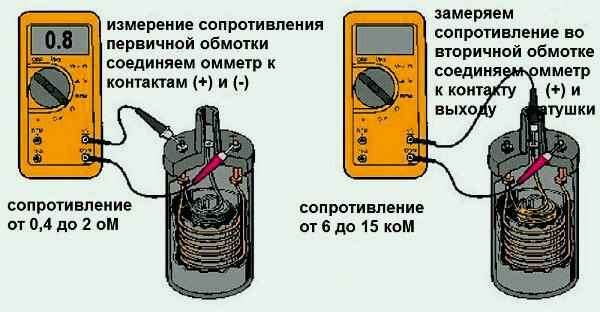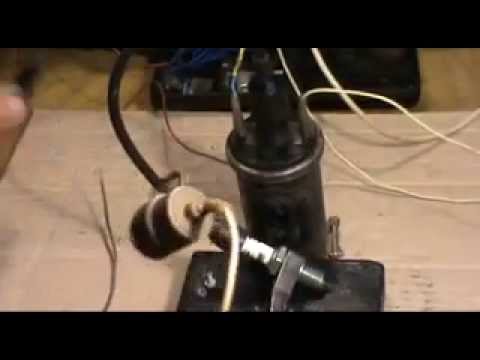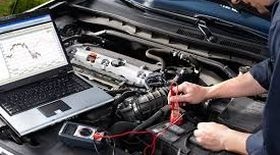
How to check the ignition coil
Content
The ignition coil is designed to create a high voltage, which is then used by the spark plug to generate a spark. Therefore, its proper operation is necessary for the normal functioning of the ignition system. In fact, the coil is a small transformer, the primary winding of which receives standard 12 V from the battery, and a voltage of several kV comes out. It is used in all ignition systems - contact, non-contact and electronic. The reasons for the failure of the coil are typical. usually, this is a wire break, insulation damage, mechanical deformation. then we will consider the signs of breakdown and methods for diagnosing the ignition coil.
The principle of operation of the ignition coil
As mentioned above, the ignition coil is a step-up voltage transformer that converts the received 12V voltage into a voltage with a value of several kilovolts. Structurally, the coil consists of two windings - primary and secondary (respectively, low and high voltage). However, depending on the type of coil, the windings and their location differ.
Let's start with the simplest common coil. Here, there are 100 ... 150 turns on the primary winding. The winding is wound with insulated copper wire. Its ends are brought to the coil body. The number of turns of the high voltage winding is 30 ... 50 thousand (depending on the model). Naturally, the wire used here is of a much smaller diameter. The "minus" of the secondary winding is connected to the "minus" of the primary. And the "plus" is connected to the terminal on the cover. this ensures that the resulting high voltage is dissipated.
in order to increase the magnetic field, the windings are wound around a metal core. In some cases, to avoid overheating, the windings and the core are filled with transformer oil (it not only cools the system, but is also an insulator).
Now let's take a look at individual ignition coil. There are also two windings here, but the difference lies in their location. namely, they are wound in reverse order. The primary winding has an inner core, and the secondary has an outer core.
Individual ignition coils are installed in systems with electronic ignition. Therefore, their design is complicated. So, to cut off a significant current in the secondary winding, a diode is provided. also a feature of an individual coil is the fact that the resulting high voltage does not go to the distributor (as in classical systems), but to the spark plugs. This was made possible thanks to the design, which included an insulated housing, a rod and a spring.
also one type of coil - two-pin. It supplies voltage to two cylinders at once. There are several varieties of them. usually, such coils are combined into one common unit, which is essentially a four-pin ignition coil.
Regardless of the type of ignition coil, their main technical parameter, which you should focus on when diagnosing, is the resistance of the windings. namely, the resistance of the primary winding is usually in the range of 0,5 ... 3,5 ohms, and the secondary - 6 ... ). Measurements are made using traditional instruments - multimeters or ohmmeters. If the value obtained is very different from the specified value, then it is likely that the coil is out of order.
you also need to be aware that each coil has different indicators:
- winding resistance;
- spark duration;
- spark energy;
- spark current;
- inductance of the primary winding.
Therefore, in order to understand how the coil readings correspond to the norm, you need to clarify the technical characteristics of your individual coil. This is especially useful to you if the spark has disappeared, since the ignition coil is one of the first elements of the system to be checked.
Symptoms of malfunctions
There are several telltale signs of a failed ignition coil. Among them:
- the motor begins to "troit", and this problem is aggravated over time;
- in the cold, the motor “troit” until it warms up;
- interruptions in the operation of the internal combustion engine in wet weather;
- when you press the accelerator pedal sharply, a failure in the operation of the motor is observed.
If the coil is faulty on machines with an ECU, the Check Engine icon on the dashboard is activated. However, the listed signs can also indicate other malfunctions, namely, with spark plugs. But when at least one of them appears, it is necessary to diagnose the ignition coil (s). When connecting a diagnostic scanner, it may show error P0363.
Causes of malfunctions
There are several reasons why the ignition coil completely or partially fails. Among them:
- Mechanical damage. This may be banal aging, due to which insulation is destroyed. there is also the possibility of oil leaking through the seals, which gets on the insulation or coil body and destroys them. Repair in this case is hardly possible, so the best option would be a complete replacement of the assembly.
- Contact connection damage. In warm weather, the cause of this may be the ingress of moisture into the engine compartment. For example, during heavy rain, driving through deep puddles, car wash. In winter, it is likely that the coil will get the composition that is sprinkled on the road surface to combat icing.
- Overheating. It often affects individual coils. Overheating can significantly reduce the life of the ignition coils. The overheating process is difficult to control, however, try to use high-quality coolant and make sure that the internal combustion engine cooling system works normally.
- Vibrations. They are especially harmful to individual ignition coils. Vibrations usually come from the cylinder head (cylinder head). in order to reduce the number and amplitude of vibrations, make sure that the internal combustion engine operates in normal mode (without detonation and with serviceable pillows).
Ignition coils are quite reliable and durable components, and their failure is most often associated with aging and / or insulation breakdown. Next, consider the methods for diagnosing coils.
How to check the ignition coil
There are two basic ways by which you can independently check the performance of the ignition coil. Let's list them in order.

Checking the ignition coil VAZ

Cherry Tiggo Ignition Coil Test
Spark test method
The first one is called "On the spark". Its advantage is the ability to perform in "marching conditions". Of the shortcomings, it is worth noting the complexity and inaccuracy, since the causes of the detected malfunctions may not be the ignition coil at all. To perform diagnostics, you will need a spark plug wrench, a spark plug that is known to be good, and pliers.
First, visually check the insulation integrity of the high-voltage wiring. Starting with spark plugs and ending with a coil. In this case, the ignition must be switched off (the key must be in position 0). If everything is in order with the isolation, the algorithm for further actions will be as follows:
- Remove the tip from the spark plug of the first cylinder and connect it to the prepared working plug.
- Turn the ignition key to position II by yourself or with the help of an assistant (start the car).
- If the coil is working, then a spark will appear between the electrodes of the candle. In this case, you need to pay attention to its color. A normal working spark has a bright purple hue. If the spark is yellowish and weak, then there are problems with the wiring or coil. If there is no spark at all, then the ignition coil is faulty.
- Repeat the described steps for all coils if they are individual in the car.
If you don't have a spare spark plug that you know is working, you can remove any spark plug from the engine. To do this, disconnect it and use the candle key. In this case, you can check the coil on all available candles. This will also check the condition of the spark plugs.
If individual coils are installed in the internal combustion engine, then you can check them by rearranging them to other candles. In this case, it is better not to touch the wiring, in order not to damage its integrity.
Ignition coil module
The "spark in a syringe" method
The process of checking the coil using such a homemade device is quite simple. To do this, you need to connect the coils in turn to the candle of the resulting “device”. Fasteners-crocodile attach to the "mass" of the car body. At the time of changing the tested coils, the internal combustion engine must be turned off and then restarted.
Initially, using the piston, you need to set the minimum gap between the wire on the piston and the electrode (1 ... 2 mm). And by adjusting the distance from the wire on the piston to the electrode on the candle, visually look at the process of the appearance of a spark between them. The maximum distance in this case will be different for different cars, and it depends on the quality and condition of the spark plug, the condition of the car's electrical system, the quality of the "mass" and other factors. Typically, a spark during such tests should appear at a distance between the electrodes from 1 ... 2 mm to 5 ... 7 mm.
The main thing that can be accurately judged during such tests is a comparison of the state of different coils by cylinders. If there is a breakdown or breakdown, this will be seen from the length of the spark compared to more or less serviceable coils.
Insulation resistance test
also one popular verification method is to measuring the insulation resistance value of wires in the coil windings. To do this, you will need a multimeter that can measure resistance. It is better to dismantle the ignition coil from the car, in order to make it more convenient to work. The measurement procedure is simple. The main thing is to know where the terminals of the primary and secondary coils are located, since you need to check both of them to measure the resistance.
Two multimeter probes are connected in pairs (touch) to the terminals of the primary winding. The resistance value should be in the range of 0,5 ... 3,5 ohms (some coils may have more, you can find the exact information in the reference literature). A similar procedure must be carried out with the secondary coil. However, here the range of values will be different - from 6 to 15 kOhm (similarly, check the information in the reference literature).
Procedure for measuring the insulation resistance of the ignition coil
If the value is small, then the insulation has been damaged in the winding, and you are dealing with a short, most likely interturn, circuit. If the resistance is too high, then this means that the winding wire has broken and there is no normal contact. Be that as it may, it is necessary to carry out repairs, that is, to rewind the winding. However, in most cases it is better to simply replace ignition coil, as this method will save you from unnecessary hassle and costs. This applies to almost any car, because the cost of repairs will exceed the price of the coil itself.
If you are dealing with individual or two-terminal coils, then the situation is somewhat different. The value on the primary winding should be similar. As for the "secondary", the resistance value will be identical on both terminals. If a coil with four terminals is installed on the car, then the check must be carried out on all terminals.
also note that it is important to consider polarity when measuring secondary resistance. namely, with the black probe of the multimeter, touch the central terminal (“ground”), and with the red one, the tip rod.
The oscilloscope will show all
The most professional way to test a coil is to use an oscilloscope. Only he is able to give complete information about the state of the ignition system, and namely, the ignition coils. Therefore, in difficult cases, it is worth using an electronic oscilloscope and additional software. This is especially true when there is a so-called interturn short circuit on the coils of the secondary voltage (with high voltage).

Checking the ignition with an oscilloscope
Checking the ignition system with an oscilloscope allows you to identify the breakdown of a specific component or simply diagnose the condition using oscillogram pulses. More details
If using an oscilloscope to remove a graph of the values of the operating voltages in dynamics (seen in the figure), then it can be understood from it that the ignition coil will be the cause of the possible malfunctions described above. The fact is that when an interturn short circuit occurs in the secondary coil, the energy that could potentially be stored in this very coil decreases, and this, in turn, leads to a decrease in the spark burning time, that is, misfiring. This is especially noticeable when you sharply press the accelerator pedal.
Coil whole
Coil punched
Results
Checking the ignition coil is not difficult at all. This can be done by anyone, even a beginner, motorist. The simplest and most effective method is to measure the insulation resistance on the primary and secondary windings. To do this, it is better to remove the coil for the convenience of work.
Remember that when a breakdown is detected, it is rarely worth repairing, namely, rewinding one or the second winding. It is much easier to buy and replace a whole new ignition coil.
